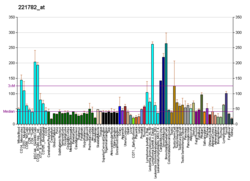Protein-coding gene in the species Homo sapiens
DnaJ homolog subfamily C member 10 is a protein that in humans is encoded by the DNAJC10 gene .[5] [6] [7]
References [ edit ]
^ a b c GRCh38: Ensembl release 89: ENSG00000077232 – Ensembl , May 2017^ a b c GRCm38: Ensembl release 89: ENSMUSG00000027006 – Ensembl , May 2017^ "Human PubMed Reference:" . National Center for Biotechnology Information, U.S. National Library of Medicine .^ "Mouse PubMed Reference:" . National Center for Biotechnology Information, U.S. National Library of Medicine .^ Cunnea PM, Miranda-Vizuete A, Bertoli G, Simmen T, Damdimopoulos AE, Hermann S, Leinonen S, Huikko MP, Gustafsson JA, Sitia R, Spyrou G (Jan 2003). "ERdj5, an endoplasmic reticulum (ER)-resident protein containing DnaJ and thioredoxin domains, is expressed in secretory cells or following ER stress" . J Biol Chem . 278 (2): 1059–66. doi :10.1074/jbc.M206995200 PMID 12411443 . ^ Hosoda A, Kimata Y, Tsuru A, Kohno K (Jan 2003). "JPDI, a novel endoplasmic reticulum-resident protein containing both a BiP-interacting J-domain and thioredoxin-like motifs" . J Biol Chem . 278 (4): 2669–76. doi :10.1074/jbc.M208346200 PMID 12446677 . ^ "Entrez Gene: DNAJC10 DnaJ (Hsp40) homolog, subfamily C, member 10" .
Further reading [ edit ]
Strausberg RL, Feingold EA, Grouse LH, et al. (2003). "Generation and initial analysis of more than 15,000 full-length human and mouse cDNA sequences" . Proc. Natl. Acad. Sci. U.S.A . 99 (26): 16899–903. Bibcode :2002PNAS...9916899M . doi :10.1073/pnas.242603899 PMC 139241 PMID 12477932 . Clark HF, Gurney AL, Abaya E, et al. (2003). "The secreted protein discovery initiative (SPDI), a large-scale effort to identify novel human secreted and transmembrane proteins: a bioinformatics assessment" . Genome Res . 13 (10): 2265–70. doi :10.1101/gr.1293003 . PMC 403697 PMID 12975309 . Gu SH, Chen JZ, Ying K, et al. (2004). "Cloning and identification of a novel cDNA which encodes a putative protein with a DnaJ domain and a thioredoxin active motif, human macrothioredoxin". Biochem. Genet . 41 (7–8): 245–53. doi :10.1023/A:1025510502147 . PMID 14587667 . S2CID 13635128 . Ota T, Suzuki Y, Nishikawa T, et al. (2004). "Complete sequencing and characterization of 21,243 full-length human cDNAs" . Nat. Genet . 36 (1): 40–5. doi :10.1038/ng1285 PMID 14702039 . Gerhard DS, Wagner L, Feingold EA, et al. (2004). "The status, quality, and expansion of the NIH full-length cDNA project: the Mammalian Gene Collection (MGC)" . Genome Res . 14 (10B): 2121–7. doi :10.1101/gr.2596504 . PMC 528928 PMID 15489334 . Hillier LW, Graves TA, Fulton RS, et al. (2005). "Generation and annotation of the DNA sequences of human chromosomes 2 and 4" . Nature . 434 (7034): 724–31. Bibcode :2005Natur.434..724H . doi :10.1038/nature03466 PMID 15815621 . Rual JF, Venkatesan K, Hao T, et al. (2005). "Towards a proteome-scale map of the human protein-protein interaction network". Nature . 437 (7062): 1173–8. Bibcode :2005Natur.437.1173R . doi :10.1038/nature04209 . PMID 16189514 . S2CID 4427026 . Otsuki T, Ota T, Nishikawa T, et al. (2007). "Signal sequence and keyword trap in silico for selection of full-length human cDNAs encoding secretion or membrane proteins from oligo-capped cDNA libraries" . DNA Res . 12 (2): 117–26. doi :10.1093/dnares/12.2.117 PMID 16303743 .
External links [ edit ] PDBe-KB provides an overview of all the structure information available in the PDB for Mouse DnaJ homolog subfamily C member 10 (DNAJC10)






Well, that’s interesting to know that Psilotum nudum are known as whisk ferns. Psilotum nudum is the commoner species of the two. While the P. flaccidum is a rare species and is found in the tropical islands. Both the species are usually epiphytic in habit and grow upon tree ferns. These species may also be terrestrial and grow in humus or in the crevices of the rocks.
View the detailed Guide of Psilotum nudum: Detailed Study Of Psilotum Nudum (Whisk Fern), Classification, Anatomy, Reproduction